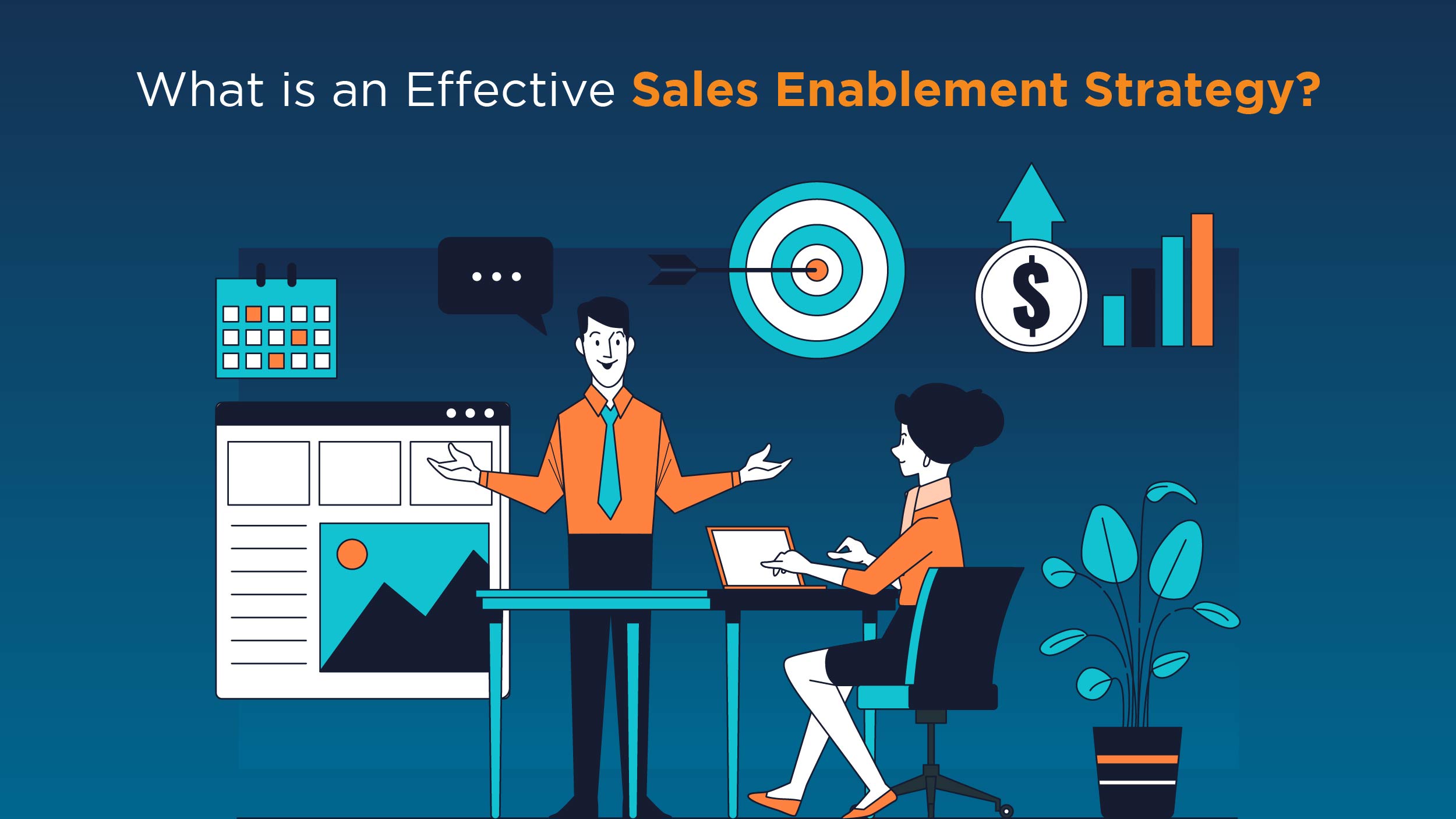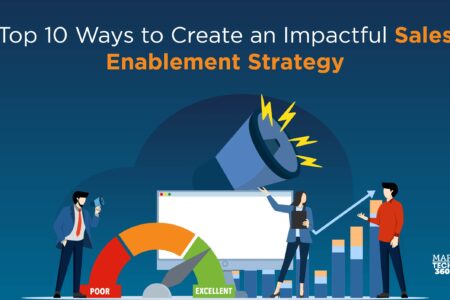The sales team is one of the most crucial components of any company. Unfortunately, 42% of sales reps require more customer details, highlighting the need for better strategies.
This is why ensuring your reps have the right resources that can help ease the buyer journey is vital.
Imagine having the best product or service, but your sales team cannot understand customer pain points due to a lack of the right tools.
Having a sales enablement strategy works wonders for such scenarios. Learn the top 10 mind-blowing sales enablement strategies to help you close more deals and drive revenue for your business.
What is Sales Enablement?
Sales enablement is a systematic and continuous process that provides sales teams with the resources, information, coaching, and assistance they need to interact with customers and close deals.
It includes mentoring, instruction, providing relevant content, utilizing technology, and optimizing procedures to enable sales professionals to engage in fruitful dialogue with clients at every point of the buyer’s journey.
What is an Effective Sales Enablement Strategy?

A sales enablement strategy is a structured business plan designed to provide sales teams with the tools and resources to sell effectively. It’s important to understand that each company’s sales enablement strategy is unique and tailored to its specific needs. This strategy typically involves analyzing sales data to find areas where sales can be improved and evaluating current sales tools to see where they can be made better.
Sales enablement content strategy acts as a link between sales leadership and sales operations. While sales leadership sets revenue goals, it’s up to sales operations to meet those targets. The sales enablement strategy outlines the technology, content, and support that sales operations require to effectively carry out their business development strategy.
Some of the sales enablement strategy tools available in the market include Zoominfo, SharePoint, Salesforce, Allbound, Seismic, and more.
How to Build A Sales Enablement Strategy?
Building a sales enablement strategy involves several key steps and considerations. Below are the top 10 effective strategies for business development.
Crafting a Customer-Centric Framework
Before sharing your sales enablement strategy with other teams and deploying it to sellers, it’s crucial to establish a clear customer-oriented framework. This framework should be easy to understand and follow, maximizing buy-in and ensuring adoption. Having a concise strategy in place facilitates communication, fosters engagement, and allows for effective measurement of success.
Setting Goals and Tracking Key Performance Indicators (KPIs)
Effective sales enablement strategies include specific goals and KPIs to measure success. Establishing deadlines for rolling out the strategy and reviewing sales enablement materials helps create benchmarks and track performance over time. Tracking common KPIs such as quota attainment, productivity, and lead quality enables continuous improvement and sets targets for future enhancements.
Providing Sales Reps With Current Information
Ensuring that everyone understands the significance of a sales enablement strategy is essential for its success. Sellers are more likely to engage with and implement sales enablement activities if they comprehend the purpose and benefits of the strategy. Effective communication of why the strategy was developed and how it can impact individuals and the organization fosters engagement and buy-in.
Centralizing Deal, Account, and Contact Information
Streamlining sales enablement processes involves consolidating deal, account, and contact information in a single, accessible location. By providing salespeople with easy access to campaign activity, previous correspondence, and contact details, valuable time is saved, allowing for more contextually relevant engagements with prospective customers.
Fostering collaboration, communication, and feedback
Successful sales enablement strategies thrive on collaboration and proactive communication between sales, marketing, and enablement teams. Establishing a dedicated sales enablement team and promoting alignment between sales and marketing enhance efficiency and effectiveness. Ongoing communication and feedback loops ensure the alignment of tasks and goals, preventing wasted resources and maximizing outcomes.
Equiping Salespeople With Effective Tools and Resources
Providing salespeople with the tools and resources they need to succeed is essential for driving sales effectiveness. Ensuring that content aligns with sales conversations and remains up-to-date minimizes the risk of using outdated or irrelevant materials. Integration with learning management systems (LMS) facilitates continuous learning and enables reps to access training resources in a contextually relevant manner.
Ensuring the Accessibility of Sales Collateral
Making sales collateral easily accessible is paramount to sales effectiveness. Utilizing intuitive sales enablement technology that aligns content with sales activities and account lists enhances accessibility. Ensuring that content is available across various platforms, including mobile and offline, enables sales reps to access materials seamlessly, regardless of their location or working environment.
Providing Comprehensive Education and Training
The value of sales enablement and CRM tools lies in the extent to which sales teams understand and utilize them effectively. Comprehensive training, particularly during onboarding for new hires, is essential for familiarizing salespeople with the organization’s tech stack. Ongoing training ensures team members stay abreast of evolving strategies, processes, and technologies.
Prioritizing Coaching
Incorporating personalized coaching into sales enablement strategies allow for the targeted development of individual strengths and weaknesses. Tailoring coaching sessions to address specific areas for improvement enhances overall sales performance and contributes to the professional growth of sales team members.
Continuously Measuring, Analyzing, and Optimizing
Sales enablement is an ongoing process that requires continuous evaluation and optimization. Regular assessment against established goals and KPIs provides insights into strategy effectiveness. Making data-driven adjustments ensures that the sales enablement strategy evolves to meet changing needs and maximizes performance outcomes over time.
Also Read: Sales Enablement: An Iterative Process To Drive Business Success
Sales Enablement Strategy Examples
Below are the best examples of how companies have used sales enablement strategies.
Slack (now part of Salesforce): Revolutionizing Sales Enablement with Collaboration
Slack, now under Salesforce, reshapes sales enablement by putting collaboration at the forefront. They focus on enhancing communication between sales and other departments, particularly marketing.
One standout strategy is Slack’s tech integration, enabling seamless communication and knowledge sharing among teams. This real-time collaboration keeps sales updated on the latest product info and marketing campaigns.
They prioritize aligning marketing and sales efforts, ensuring consistent and effective messaging. This collaboration yields higher-quality leads and more successful sales engagements.
Despite its short independent journey, Slack’s emphasis on collaboration and tech integration showcases the power of a unified sales enablement approach.
HubSpot: Making Sales Enablement a Core Strategy
HubSpot, renowned for its inbound marketing and sales software, underscores the importance of sales enablement. Their strategy revolves around aligning marketing and sales efforts to deliver a seamless customer journey.
A key pillar of HubSpot’s approach is content development, which generates valuable resources like blog posts, ebooks, and webinars. This content not only educates potential customers but also empowers the sales team to effectively engage and nurture leads.
Moreover, HubSpot prioritizes training and onboarding for its sales representatives, ensuring they are well-equipped with product knowledge, sales techniques, and an understanding of customer personas. Their dedication to continuous learning contributes significantly to their success.
The End
A successful sales enablement strategy doesn’t just impact sales—it transforms the entire content process. It fosters greater collaboration among teams, strengthens alignment between departments, and unlocks valuable insights that drive informed business decisions.

